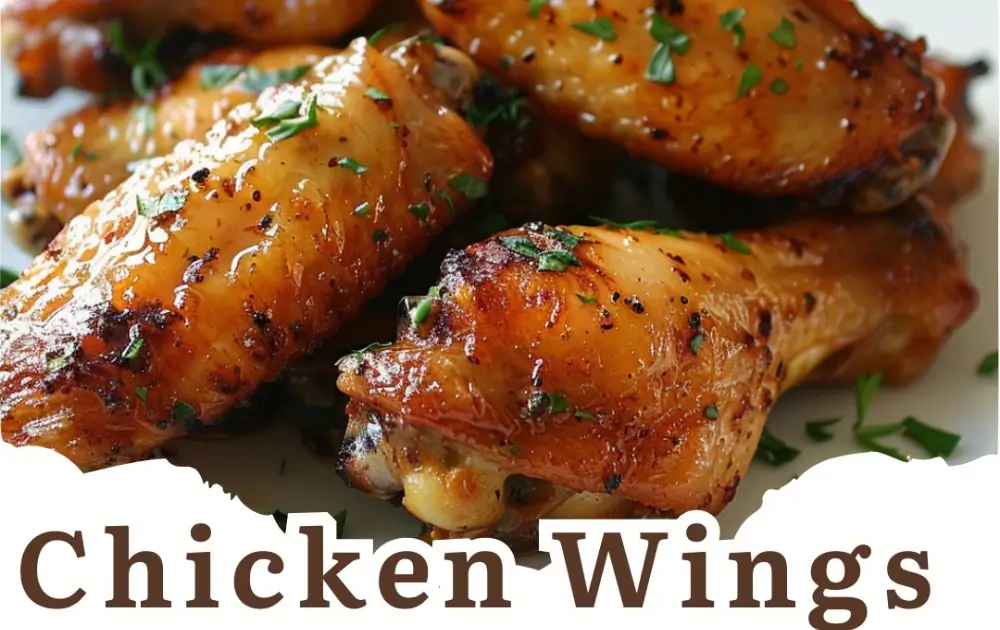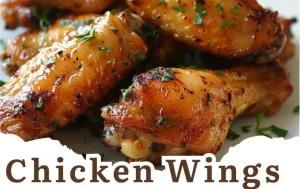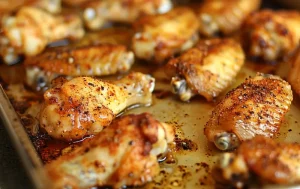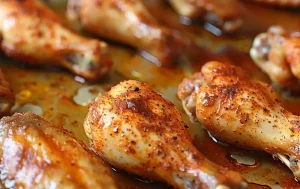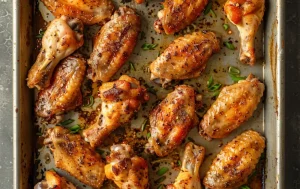Chicken wings have soared in popularity to become one of the most beloved comfort foods worldwide. Originating as a simple dish, they have transformed into a culinary canvas for a myriad of flavors, cooking techniques, and presentations. From the classic Buffalo style to innovative sweet and savory glazes, chicken wings offer something for every palate.
Print
Chicken Wings
- Author: recipstep
- Total Time: 1 hour
- Yield: Serves 4
- Diet: Gluten Free
Description
A classic favorite, chicken wings are versatile, delicious, and perfect for any occasion. This guide covers a basic recipe that can be adapted with various sauces and flavors to suit any palate.
Ingredients
▢1 tablespoon baking powder
▢2 teaspoons ground black pepper
▢2 teaspoons paprika
▢2 teaspoons garlic powder
▢1 teaspoon kosher salt
▢4 pounds chicken wings split with tips removed, patted dry (1.8 kg)
▢¼ cup unsalted butter melted (60ml)
Instructions
In a large bowl, combine the baking powder, pepper, paprika, garlic powder, and salt. Add the chicken wings and toss until well-coated. Spread the wings into an even layer on the prepared baking sheet.
Bake for 20 minutes until the skins are golden brown and the internal temperature reaches 165°F on an instant-read thermometer. Let cool for 10 minutes.
Transfer the wings to a large mixing bowl, reserving the drippings.
In a small mixing bowl, whisk together melted butter and reserved drippings. Add the butter mixture to the bowl with the chicken wings, tossing to coat. Serve immediately.
Notes
- Ensure wings are fully thawed and dry before seasoning for the crispiest result.
- Adjust cooking time based on the size of the wings.
- For spicier wings, add chili powder or cayenne pepper to the seasoning mix.
- Gluten-Free (check sauce ingredients).
- Prep Time: 10 minutes
- Cook Time: 50 minutes
- Category: Appetizer/Main Course
- Method: Baking
- Cuisine: American
Nutrition
- Calories: 430
- Sugar: 0g (varies with sauce)
- Sodium: 800mg (varies with sauce)
- Fat: 31g
- Saturated Fat: 10g
- Carbohydrates: 1g
- Fiber: 0g
- Protein: 35g
- Cholesterol: 145mg
FAQs
What’s the best way to cook chicken wings to ensure they’re crispy?
For the crispiest wings, baking them on a wire rack over a baking sheet in the oven allows air to circulate around the wings, crisping them up evenly. Coating the wings lightly with baking powder (not baking soda) can also help make the skin extra crispy.
Can chicken wings be made healthier?
Yes, chicken wings can be made healthier by opting for baking or air frying instead of deep frying. Using skinless wings or incorporating nutritious marinades and seasonings can also reduce the calorie and fat content.
Are there any good alternatives to traditional chicken wings for vegetarians?
For vegetarians, cauliflower wings make an excellent alternative. They mimic the texture of chicken when baked and can be coated in the same variety of sauces and seasonings.
How long should I marinate chicken wings for optimal flavor?
Marinating chicken wings for at least an hour can infuse them with flavor, but for deeper penetration of the marinade, leaving them in the fridge overnight is ideal.
What are some unique flavor combinations for chicken wings?
Beyond the classic Buffalo or BBQ flavors, unique combinations like honey sriracha, garlic Parmesan, or maple bacon can offer an exciting twist on traditional wing recipes.
The Evolution of Chicken Wings
The journey of chicken wings from a budget-friendly option to a menu staple at sports bars and restaurants is a fascinating tale of culinary innovation. Initially considered a byproduct of chicken processing, wings gained fame in the 1960s with the creation of the Buffalo wing in New York. This spicy and tangy recipe sparked a nationwide, then global, interest in chicken wings, leading to the diverse range of recipes we enjoy today.
Preparation and Marinades
Preparing chicken wings involves several key steps to ensure they are flavorful and tender. The process starts with marinating the wings in a mixture of spices and sauces, which can range from simple salt and pepper to complex blends of herbs and spices, depending on the desired flavor profile. Marinating not only seasons the wings but also tenderizes them, resulting in juicy, flavorful meat after cooking.
Cooking Techniques
There are numerous ways to cook chicken wings, each offering a different texture and flavor. Deep-frying is the traditional method, giving the wings a crispy exterior and tender interior. Baking and grilling offer healthier alternatives, with the latter adding a smoky flavor that complements the marinade. Air-frying has also become a popular method, producing wings that are crispy on the outside and juicy on the inside with less oil.
Sauces and Glazes
The versatility of chicken wings is perhaps best demonstrated in the wide array of sauces and glazes used to coat them. Classic Buffalo sauce remains a favorite, but barbecue, honey mustard, teriyaki, and even exotic flavors like mango habanero or lemon pepper have become popular. These sauces can be applied before cooking for a deeper flavor infusion or after as a glaze that adds a final punch of taste.
Serving and Presentation
Chicken wings are typically served with dipping sauces on the side, such as blue cheese or ranch dressing, which provide a cooling contrast to the heat of the wings. Celery and carrot sticks are also common accompaniments, offering a crunchy, fresh counterpoint to the rich, savory wings. Presentation varies from casual, piled high on a platter, to more elegant arrangements for sit-down meals, showcasing the wings’ versatility across dining contexts.
Cultural Impact and Global Popularity
The global popularity of chicken wings is undeniable, with variations found in cuisines around the world. In addition to their presence in American sports bars and casual dining establishments, wings have found their way into the menus of gourmet restaurants, street food stalls, and home kitchens globally. This widespread appeal speaks to the universal love for this simple yet satisfying dish, transcending cultural and culinary boundaries.
Nutritional Considerations
When it comes to nutrition, chicken wings offer a good amount of protein but can be high in fat, especially when deep-fried. Opting for baking, grilling, or air-frying can reduce the fat content significantly. Many chefs and home cooks are also experimenting with skinless wings or using alternative seasonings to lower sodium levels, making the dish more health-conscious without sacrificing flavor.
Creative Serving Ideas
Beyond the traditional serving methods, creative chefs are incorporating chicken wings into a variety of dishes. From wing-topped pizzas to wing-flavored soups and even wing-stuffed sandwiches, the possibilities are endless. These innovative serving ideas not only highlight the versatility of chicken wings but also cater to the evolving tastes and preferences of diners looking for the next great flavor experience.
Pairing with Beverages
Finding the perfect beverage to complement the rich flavors of chicken wings is an art in itself. Craft beers, particularly IPAs, have become a popular choice for their ability to cut through the fat and complement the heat with their hoppy bitterness. For non-alcoholic options, iced tea or lemonade provides a refreshing balance to the spice and savoriness of the wings.
Sustainability and Ethical Considerations
As chicken wings continue to grow in popularity, sustainability and ethical sourcing have become important considerations for both consumers and producers. Many restaurants and suppliers now prioritize locally sourced, free-range chicken to ensure higher quality and more environmentally friendly practices. This shift not only impacts the quality of the wings but also supports local agriculture and reduces the carbon footprint associated with long-distance food transportation.
Global Influences on Wing Recipes
The global influence on chicken wing recipes is vast, with flavors and ingredients reflecting a mosaic of international cuisines. From Korean gochujang to Jamaican jerk spices, these global influences introduce a new world of tastes to chicken wing enthusiasts. Such diversity not only broadens the culinary landscape but also fosters a deeper appreciation for the flavors and cooking techniques from around the world.
Community Events and Wing Competitions
Chicken wings have become a focal point of community events and competitions, where aficionados gather to showcase their recipes, cooking techniques, and devouring skills. Wing festivals and contests draw large crowds, eager to sample a wide range of flavors and vote for their favorites. These events not only celebrate the beloved chicken wing but also bring communities together over shared food experiences.
By embracing these diverse aspects of chicken wing culture, from health and sustainability to global influences and community engagement, the humble chicken wing continues to be a dynamic and cherished element of global cuisine.
The Role of Social Media in Popularizing Chicken Wings
Social media platforms have played a significant role in the rise of chicken wings’ popularity. Food bloggers, chefs, and enthusiasts share photos, recipes, and videos of their latest wing creations, inspiring a global audience. These platforms also facilitate the sharing of tips, such as achieving the perfect crispiness or mastering a new sauce. As a result, an online community of wing lovers has formed, exchanging ideas and fueling a continuous cycle of culinary innovation.
Incorporating Wings into Special Diets
As dietary preferences evolve, so do the recipes for chicken wings. There are now numerous adaptations available for those following keto, paleo, gluten-free, and even plant-based diets. Whether it’s using almond flour for a keto-friendly breading or exploring meat alternatives for vegan wings, the adaptability of chicken wings ensures they remain accessible to everyone, regardless of dietary restrictions.
The Science Behind Perfect Wings
Achieving the perfect chicken wing is a science in itself, involving the right balance of temperature, cooking time, and ingredient ratios. Food scientists and chefs have explored methods such as brining wings to enhance moisture retention, using baking powder to crisp the skin, and the effects of different fats on flavor absorption. These insights have significantly improved the quality of homemade and restaurant-prepared wings, elevating the dish to new heights.
Wings as a Cultural Phenomenon
Chicken wings have transcended their status as mere food, becoming a cultural phenomenon in their own right. They are a staple at major sporting events, the centerpiece of dining experiences, and a symbol of communal eating and celebration. The passion for wings has led to the creation of documentaries, dedicated food channels, and even scholarly articles exploring their impact on food culture and social interactions.
Educational Opportunities in Wing Preparation
Recognizing the complexity and popularity of chicken wings, culinary schools and cooking classes now often include sessions dedicated to wing preparation. These educational opportunities cover everything from the basics of selecting and preparing wings to advanced techniques in flavoring and presentation. Aspiring chefs and hobbyist cooks alike can hone their skills, learning to create restaurant-quality wings at home.
Looking to the Future of Chicken Wings
As we look to the future, the evolution of chicken wings shows no signs of slowing down. Emerging trends include the exploration of sustainable meat alternatives, the fusion of traditional wing recipes with cutting-edge culinary techniques, and the continued emphasis on health-conscious options. Whatever direction the world of chicken wings takes, one thing remains clear: their ability to bring people together over a shared love of good food will continue to make them a beloved dish worldwide.
Embracing Sustainability in Wing Production
The chicken wing industry increasingly focuses on sustainability, recognizing the importance of responsible farming practices. Producers are adopting methods that prioritize animal welfare, reduce water usage, and minimize the carbon footprint associated with wing production. This shift towards sustainability not only appeals to environmentally conscious consumers but also ensures a more ethical and sustainable future for poultry farming.
Technological Advances in Cooking Wings
Technological advancements have revolutionized the way chicken wings are cooked and served. From precision cookers that ensure perfectly cooked wings every time to innovative frying equipment that reduces oil usage, technology is at the forefront of enhancing the wing-eating experience. These advancements not only improve efficiency in commercial settings but also make cooking wings at home more accessible and enjoyable for enthusiasts.
The Impact of Food Festivals on Wing Popularity
Food festivals dedicated to chicken wings have become pivotal in driving their popularity. These events offer a platform for chefs to showcase their culinary skills and for enthusiasts to indulge in a variety of flavors and cooking styles. The competitive atmosphere encourages innovation, with participants striving to create the next award-winning wing flavor. These festivals not only celebrate the dish but also contribute to its evolving landscape, introducing new trends and tastes to the public.
Nutritional Innovations in Wing Recipes
As health awareness grows, nutritional innovations in chicken wing recipes are becoming more prevalent. Chefs and home cooks are experimenting with ingredients that offer health benefits without compromising on taste. From using heart-healthy oils for frying to incorporating antioxidant-rich spices in marinades, these innovations aim to make chicken wings a more balanced option for health-conscious individuals.
The Role of Chicken Wings in Social Gatherings
Chicken wings continue to play a central role in social gatherings, from family dinners to large-scale events. Their shareable nature fosters a sense of community and interaction among diners. The versatility of wings, with countless flavors and preparations, makes them a unifying food choice that can cater to diverse tastes and dietary preferences, underscoring their importance in fostering social bonds.
Future Trends in Wing Consumption
Looking ahead, trends in wing consumption are likely to focus on global flavors, plant-based alternatives, and interactive dining experiences. The fusion of international cuisines will introduce diners to new flavor profiles, expanding the culinary horizons of wing lovers. Plant-based wing alternatives will cater to the growing demand for vegetarian and vegan options, while interactive dining experiences, such as DIY wing bars, will offer a personalized approach to enjoying this beloved dish.
Preserving the Cultural Heritage of Chicken Wings
As chicken wings continue to evolve, efforts to preserve their cultural heritage become crucial. Documenting the history of wings, from their humble beginnings to their status as a global phenomenon, ensures that future generations understand the significance of this simple yet profound dish. Celebrating the origins and traditions associated with chicken wings helps maintain their legacy, ensuring they remain a cherished part of culinary culture worldwide.
Conclusion
Chicken wings, with their rich history and global appeal, continue to be a favorite for many around the world. From their origins as a simple, economical food to their current status as a versatile culinary phenomenon, wings have proven their staying power. The evolution of chicken wings, driven by innovation in cooking methods, flavors, and dietary adaptations, highlights their versatility and the universal joy they bring to dining tables. As we look towards the future, chicken wings are set to remain a beloved snack, appetizer, and meal, embodying the spirit of communal dining and culinary exploration. Whether enjoyed at a family gathering, a sports event, or a casual dining establishment, chicken wings will continue to unite people over shared meals and memorable flavors, cementing their place in the rich tapestry of global cuisine.

